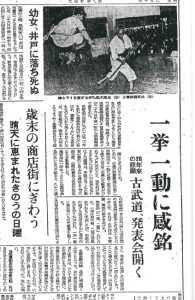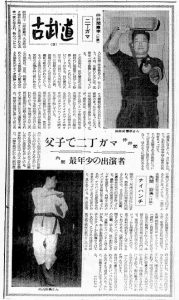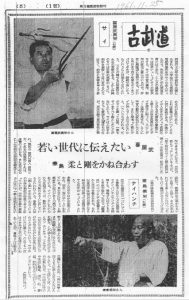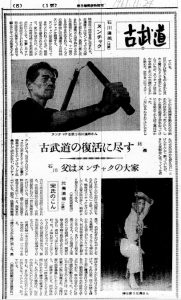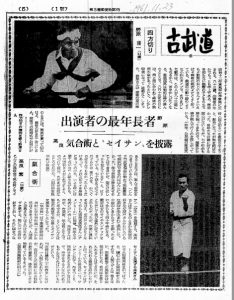Special feature articles
-
2023.09.19
Karate Today - Yoshizato Hiroshi's Birth!
-
2023.08.29
Karate Today - Honolulu Karate Youth Club Found...
-
2023.08.15
Karate Today - Nakandakari’s Birth!
-
2023.08.03
Karate Today - Noma Seiji made his wedding in O...
-
2023.07.18
Karate Today - Yabu Kentsu conducts Karate prom...
-
2023.07.04
Karate Today - First "Karate Club" created for ...
-
2023.06.20
Karate Today - Yoshimura Chogi visited the form...
-
2023.06.06
Karate Today - Karate club at Prefectural First...
-
2023.05.26
Karate Today series will begin
-
2021.12.20
Martial arts demonstration in front of the king...
-
2021.03.08
Folktale: Why tigers can't climb trees
-
2020.12.22
About Rei – Part 2 by Nakamoto Masahiro
-
2020.11.17
Okinawa Karate "WA" Series
-
2020.10.05
About Rei – Part 1: Mabuni Kenei
-
2020.06.19
1969 article on master Yagi and Sūpārinpe
-
2020.05.22
1969 article on master Higa and Passai Dai
-
2020.05.08
1969 article on master Shimabukuro and Ānankū
-
2020.04.20
1969 article on master Kushi and Wankan
-
2020.04.14
1969 article on masters Kaneshima and Nagamine
-
2020.04.09
Article ”Even at 80 years old “Eyaa!” ” (Okinaw...
-
2020.04.09
Article ”Impressed with every move” (Ryūkyū Shi...
-
2019.12.03
Kobudō 9: Nakaima Kenkō and Uchima Anyū
-
2019.11.07
Kobudō 8: Kyan Shinei and Kaneshima Shinei
-
2019.10.29
Kobudō 7: Ishikawa Hōei and Higa Seitoku
-
2019.10.08
Kobudō 6: Nohara Kamaichi and Takara Shigeru
-
2019.09.13
About the estimated new photo of Itosu Ankō
-
2019.09.02
Karate policemen protecting the safety and secu...
-
2019.07.02
Kobudō 5: Soken Hōhan and Shiroma Taisei
-
2019.06.08
Kobudō 4: Kameshima Shinsuke and Chinen Masami
-
2019.06.01
Kobudō 3: Nakamura Shigeru and Higa Yūsuke
-
2019.05.24
Kobudō 2: Irei Matsutarō and Nakamura Heisaburō
-
2019.05.14
Kobudō 1: Kina Shōsei and Shinjō Heisaburō
-
2019.04.08
Questioning the weapons’ hunt
-
2019.01.21
Kyō Ahagon Jikki, the sword and karate
-
2018.05.04
The unveiling of the statue of Uechi Kanbun
-
2017.12.26
Following the steps of Matsumora Kōsaku
-
2017.10.20
Brushwork of late Matsumura Sōkon
-
2017.10.14
Maekawa bō performed at the Shihan Gakkō
-
2017.09.08
The declaration of the "Karate Day"
-
2017.08.15
A district connected to karate, Uebaru
-
2017.07.14
The beauty of Okinawa karate
Impressed with every move
A 20 years long-cherished wish
A kobudō demonstration held
Published in the Ryūkyū Shimpō newspaper of November 27, 1961
Sponsored by the Kobudō Association with the support of the Okinawa Times and the Ryūkyū Shimpō, the “Kobujutsu Demonstration” was held at the Naha Gekijō Theater on the afternoon of January 26th from PM1:00 with the intent of preserving and disseminating the martial arts (1) that have been passed down locally for a long time.
Concerned about the preservation of martial arts, related people have been eagerly preaching out for more than two decades. Preservation through photographic filming was also thought about at some time, but it did not bear fruit. Finally, the demonstration was held 16 years after the war.
On this day, the venue that was Naha Theater was filled with an enthusiastic crowd, including people from far away Minami Daito. Two hours before the beginning at AM 11:00, the room was filled by 80% and when the demonstration started, the hall was packed with no room to stand. A large number of late-arrived people stood outside the venue, and many famous people from various fields, including Chief Executive Ōta and Tōma Jūgō (2) were also present.
The demonstration started with a greeting speech from the Association’s president Mr. Higa. It was followed by 83 years old Nohara Kamaichi, first on the list of more than 70 people kobudō seniors and their students from the entire Ryūkyū islands. All performed their unique skills and received warm applauses from the audience.
The event was divided into two parts. The first part introduced mainly demonstrations from young people while the second part comprised mainly performances by seniors. Yet, the martial arts performed by the seniors were truly honed over the years, and the crowd was fascinated by the elegance of each move.
According to the president of the association Higa Seitoku, the performers who participated in the demonstration were still a small part of the whole, and whenever there will be a chance, he would like to introduce those who could not perform this time.
Chief Executive Ōta, who saw the demonstration commented as follow.
Words from Mr. Ōta: I was very impressed. The preservation or dissemination of old martial arts is also significant in the creation of a new culture. It is necessary to preserve the brilliant culture of Okinawan ancestors. Furthermore, as performers came not only from Naha and Okinawa main island but also from Minami Daito I learned that kobudō is popular and has spread throughout all the Ryūkyūs. This is really reassuring.
Words from Tōma Jūgō, chairman of the Sport Association: I came with the interest of seeing martial arts that I haven't seen before. The kon or staff martial arts as in Tenryū-no-kon, Yonegawa-no-kon, Sakugawa-no-kon was good. I have been watching kobudō for many years since I was a student, but this is the first time that the elders of all the Ryūkyūs gathered and performed together. I am delighted that they held such a good event.
(1) In the original text written as “Bujutsudō”
(2) Ōta Seisaku was the Chief Executive of the Government of the Ryūkyū Islands from October 1959 to November 1964. Tōma Jūgō was Mr. Ōta’s predecessor.
November 26, 1961
Kobudo 9
Father-and-Son's Nichō-gama
Nakaima Kenkō (51)
Nichō-gama
Born in 1910 in Kume, Naha into a family of martial artists referred to as the “Bō Nakaima,” Kenkō has been practicing karate for as long as he can remember. According to Kenkō, he had achieved a general mastery of his martial art by the time he was fourteen or fifteen years old.
His martial art is one mastered by his grandfather, Norisato (1), who studied it in Fujian China during the Qing dynasty. Kenkō shared an episode about this with us. Around the time his grandfather, Norisato, was fourteen or fifteen years old, a burglar entered his house on the night 10,000 cash coins in strings had been dropped off by a moai (2) support group. Thanks to the quick-witted response of a neighbor a bad outcome was avoided, but the incident made Norisato feel it was his obligation as a man to learn a martial art, and so he began training.
Around the time his martial art came to be known in Shuri and Naha, Norisato gave an exhibition of a tai (3) form at a party welcoming a ship of emissaries from China. His performance drew the attention of a Qing official and eventually lead to Norisato’s studies abroad.
Norisato trained for three years in Fujian before returning home. He never took any disciples, but instead passed the art down secretly from child to grandchild, keeping it within the Nakaima household. As a result, many aspects of the art were never made public, including its tai, kama, and bō weapons forms, as well as tenbe, shuchin, and more.
Mr. Nakaima has also mastered Okinawa’s unique equestrianism and it is said he is the island’s only school principal to own riding horses. “Military arts (4) were originally intended to kill people, but when the principles of morality are brought into play and the art is refined to the level of a philosophy, that is when it becomes a martial art (5),” he said, taking a small jab at the recent karate manslaughter incident at Takushoku University.
Regarding the kobujutsu that will be demonstrated, he noted that “we need to preserve the arts not simply because they are old, but because they have true value.” With that in mind, rather than picking one of the many newer alternatives, he chose to perform nicho gama and he’s eager to compare his techniques to those of other sickle users. Mr. Nakaima will be performing the kata Nicho-gama Nidan, and Ichidan will be performed by his second son, who is attending the University of the Ryūkyūs, making it a father-and-son performance.
https://www.youtube.com/watch?v=skD9iTGYVA8&feature=share&fbclid=IwAR3ZGSnTxP-q91fSmtqNAoB3lXfeC0RcMV3pXlLORti7K1Yjg2Vx3JyK6jw
Notes:
(1) Can also be read Kenri
(2) Moai are social groups formed in order for members to provide each other various types of support. Many Okinawans have monthly Moai gathering that last for decades with longtime friends, school mates, club members, etc.
(3) Written "Tai" in Hiragana in the text.
(4) Written Bujutsu in the text.
(5) Written Budō in the text.
The Youngest Performer
Uchima Anyū (23)
Naihanchi
Born in 1938 in the North Ward of Minamidaitō Island, Anyū is the only participating performer from a remote island. He arrived in Naha on the fourth, earlier this month, and is staying at the home of President Higa while waiting his turn to perform. Anyū, the youngest of the performers, will be demonstrating Naihanchi. While his Naihanchi differs from that of the main island, some suspect it has actually preserved the original Naihanchi form.
Anyū receives instruction from his uncle, Yasuichi, who studied karate in the South Sea Islands before the war while living under the same roof as Motobu Choyū’s son, Torajū (a nickname). Mr. Motobu was a disciple of Shuri’s Bushi Matsumura and Yasuichi received instruction from Choyū’s son, Torajū, which links Anyū to Bushi Matsumura’s lineage. When President Higa saw Anyū’s Naihanchi, he commented that “The eye positioning and movement of the hands, feet, and body are different from the Naihanchi of the main island. Since your uncle received instruction from Motobu Choyū’s son, Torajū, your upcoming demonstration may give us a glimpse of the original Bushi Matsumura form. Everyone will be watching your Naihanchi with great interest.” Karate has yet to catch on in Minamidaitō - the only practitioners there are Yasuichi, his son, and Anyū. Anyū began training at the age of fourteen and currently devotes any time not spent helping with farming to his karate practice.
“I’m really happy to be performing at the demonstration. I’ll get to see the kobudō of my seniors from the main island, and I also wanted to perform in front of everyone one more time,” he said, clearly looking forward to his performance.
Some more information on Uchima Anyū and the mentioned Naihanchi is available on the Motobu-ryū Blog and Motobu Chōmo alias Torajū.
November 25, 1961
Kobudo 8
Eager to share with the younger generation
Kyan Shinei (49)
Sai
Born in 1912 in Higa, Kitanakagusuku, Shinei began studying martial arts with one of his elementary school teachers he admired, Kina Shosei, a well-known sai expert. At the upcoming demonstration, the master and student will give a sai demonstration together. The wrist handling and the rich variation of movements make the sai a very interesting weapon. This is why he’s never dreaded practice in over forty years of training with the sai. “Every country has martial arts to protect its people. However, Okinawa’s sai is not meant to stab and kill an opponent to protect oneself like other martial arts and weapons around the world, but rather to subdue the opponent without causing them harm. This has a profound significance that cannot be done with words.
Okinawa’s sai is a weapon modeled after the human body, a fact which symbolizes its philosophy of peace,” Shinsei explained as he gripped a human-shaped sai in each hand and showcased several quick moves. The movement variation of his wrists is so striking that one can’t help but break into a cold sweat imaging the worst-case scenario - a strayed sai flying to the side. But he says a sai has never slipped out of his hand even once since first picking the weapons up. While the idea itself of shaping the sai like a human is admirable, the design also resulted in a weapon that could be freely controlled by the five fingers, making the sai ideal for an art of offense and defense. It also seems fitting of the sai’s techniques. “I want to make a physical education course that uses my hometown’s unique sai and bō as equipment for sport. Martial arts demonstrations are currently often done solo, but group demonstrations would be good not only for physical education but also from a general education perspective since they would serve to carry on the wonderful kobujutsu that our ancestors entrusted us with,” he continued, before adding that it is our duty to share these arts with many people of the younger generation.
(Current Secretary-General of the Okinawa Teachers' Association)
Combining hard and soft
Kaneshima Shinei (61)
Naihanchi
Mr. Kaneshima, who practices karate as a way to stay healthy, will perform Naihanchi and Sanchin at the upcoming demonstration. Mr. Kaneshima was a weak child, thus his father Shinbi taught him karate as one “way of heath”. Ever since, it has been part of his daily routine and he trains every single morning, rain or shine.
The karate Mr. Kaneshima practices is called Ishimine-ryū, also known as “Kuma-no-te”(1). While it may appear a bit unattractive, the style is dominating and overflows with a sense of power. It has several kata next to Naihanchi, and their bold movements are a good fit for powerful practitioners. Mr. Kaneshima explained that a balance of “hard and soft” is a distinguishing characteristic of Ishimine-ryū, and when he dons his karate gi he seems far younger than one might expect at sixty-one years of age.
Still able to read without relying on glasses, he asserted his good health by displaying Sanchin. “While it was my father who introduced me to martial arts, not once have I ever felt like practicing karate was a chore,” he said. Karate training is intense, and it’s considered normal for a practitioner to give up at least once in their career. But because training has always been a part of his daily routine, Mr. Kaneshima claims he looks forward to his sessions just like one might look forward to the 3 daily meals.
At the age of nineteen, he moved to Tōkyō to study law at Nihon University and spent his time as a student diligently training in karate and judo. Now, he spends his days enjoying life while painting, practicing calligraphy, and reciting poetry.
(Works at the Public Prosecutors Office)
Notes:
In both articles, although the characters for ei of Shinei differ, both given names should be pronounced Shin-ei.
(1) Kuma-no-te could mean bear’s claw
November 24, 1961
Kobudo 7
Father, the Nunchaku Master
Ishikawa Hōei (50)
Nunchaku
Born in 1911 in Shuri into a family of martial artists—his father Hōkō was known as a master of nunchaku—Hōei grew familiar with kobujutsu from the time he was a child and began training in karate at the age of eleven. During the demonstration, he will perform the specialty of his father Hōko, the nunchaku.
The nunchaku is said to have come from China, but the weapon never gained much popularity before the war, making practitioners rare. The nunchaku has a wider range of use than the bō, and the ease of attack is said to be one of its advantages. Hōei took some kata of karate and modified them to create his own original nunchaku kata.
While karate was an intimate part of his life from childhood, Hōei didn’t begin using the nunchaku until he graduated from Nippon Sport Science University at the age of twenty-three. Since he’d already mastered karate by the time he began kobujutsu, it could be said Hōei was a late starter. However, his natural dexterity helped ensure his quick advancement after he began practicing.
“My father went easy on me, so I didn’t train hard. I’m not even half as proficient as he was,” Hōei humbly revealed, although he is clearly fired up about the coming demonstration. He spoke about the mindset required for one training with the nunchaku, saying “Just because attacking is easy doesn’t mean you can be reckless. The practitioner’s intention will determine whether the nunchaku becomes a weapon for self protection thus being useful or a deadly weapon.” Many young people began practicing nunchaku after the war, and the weapon is becoming more popular than it was before the war.
https://www.youtube.com/watch?v=yePfZ4_DDag&feature=share&fbclid=IwAR3-TzqFjLW0vUqc57rbewUl3xzxJzis5lMOQrsuZpY454bH-ri1o9HGlN0
Dedication to the Revival of Kobudō
Higa Seitoku (41)
Soshi no Kon
Born in 1921 in Sueyoshi, Shuri. The President of the Kobudō Association, he is extremely passionate about reviving kobudō. “My love for martial arts is pure—it transcends styles. I hope to revive the kobudō of my hometown,” he said, sharing his ambitions. Currently Head of Civil Affairs at the Regional Legal Affairs Bureau, Seitoku wears glasses and has a kind appearance. You wouldn’t believe him if he told you he was a bō expert, but as soon as he puts his karate gi on and picks up his bō, he begins to exude intensity and a certain sharpness. When he performed the Soshi no Kon kata that he will show at the demonstration, the sounds of his bō slicing through the air and joints cracking rang out as he made his way around the entirety of the dojo. Perhaps this is what is meant by the phrase “kakure bushi,” or hidden warrior. Soshi no Kon is a Yamane-ryū basic kata and Seitoku learned it from the style’s creator, Chinen Masami.
The photograph shows a single frame of the Soshi no Kon kata in which the entire body is defended using a single bō.
He began learning the bō around the age of ten, starting with an introduction from his uncle, and for more than forty years since, he’s devoted himself completely to the weapon. While studying law at Chuo University in 1929, he gave frequent martial arts demonstrations, primarily at student association gatherings. During school breaks, he would read novels on Miyamoto Musashi for inspiration and travel all over Japan training diligently. “I would sleep out in the open or spend the night at a temple if it was raining. Sometimes I would train myself mentally by sitting under a waterfall. That kind of training was really advantageous for daily life too. It also made for some good memories from my time as a student,” he said.
[Okinawa Times] November 23, 1961
Kobudō 6
The eldest performer
Nohara Kamaichi (83)
Shihō-kiri
Born in 1879 in Tomimori, Kochinda Village. 83 years old. It is the oldest among the performers. Even children in the hamlets who do not know Bōjustu are well aware that when “grandpa Nohara” is mentioned, it means the “master of Bōjustu”.
A small built man like Mifune Jūdan (1), his vigorous moves do not betray a man of 83 years.
Before WWII, the Tomimori hamlet was famous for Bō, and on the day of August 15th, there was a Bōjustu demonstration with the hamlet being divided into south and west. However, it was interrupted after WWII. Mr. Nohara tried hard to revive the hamlet traditional Bōjustu (Shihō-kiri), but he did not succeed. It seems that young people have no interest in the cudgel. As he has handled the staff for more than 70 years, he is sad that the Bō is going to die in the community.
Last year, for the opening of the community center, this grandpa who loves Bōjustu performed a demonstration. For the hamlet’s wedding ceremonies, celebrations and the likes, he is always delighted to perform.
"It is really good to be able to perform at the Naha Theater on the recommendation of the Kodudō Association soon. Because of my age, I cannot show a lively cudgel anymore but I firmly remember the kata," he said enthusiastically.
Until the age of seventy, it was nothing for him to handle a staff of 70 kin (2), thus he has managed to perform lightly ‘Shihō-kiri’. Although he says that “One can’t beat aging”, he goes on performing vigorously what is “Sanpō-kiri”.
(Present address: Kochinda Village, aza Tomimori)
Notes:
(1) Jūdō master Kyūzō Mifune (1883 – 1965)
(2) 1 kin is approximately 600 grams
https://www.youtube.com/watch?v=MMYkaDw08z4&feature=youtu.be&fbclid=IwAR0jqupvhfA5OlW-80GNrxlE5-QqGmLWsUapXNXfwbzX9UqPtgJTbQt3dx8
Perfoming Kiai-jutsu and ‘Seisan’
Takara Shigeru (53)
Kiai-jutsu
During the next demonstration, he will perform Kiai-jutsu and Seisan (karate). Mr. Takara grew up learning various martial arts from his father, Mr. Kamado, who loved martial arts since childhood. It has been more than 40 years since he held a sai trident at the age of ten years old.
At first, he took out his father's sai and nunchaku and used them as fun toys but gradually became interested. After the passing of his father Kamado, he studied under Kyan Chotoku (Chanmī-gwa) and began to practice karate earnestly. Mr. Takara can perform either karate, kobudō or Kiai-justu, but this time, in particular, the association requests him to perform Kiai-justu and Seisan.
He was introduced to “Kiai-justu” by Mr. Tamura Yoshikazu, who lives in Tomita Village in Chiba Prefecture, but he demonstrates a technique that seems to be unhuman. Passing an approximately 20 cm long needle through his arm and attaching a chain to it, he then pulls a large passenger car, or pass the car over his stomach, truly techniques unbelievable for human. Since the venue at the Naha Theater is small, a car cannot be used. Yet he says that he still wants to introduce a secret technique for a change. Seisan is one of the kata of Chanmī-gwa. Similar to Sanchin, the main purpose is to develop the form and train muscles, and he says that anyone who practices karate must temper this way.
Kiai-jutsu needs at least 20 years of practice to be mastered. But the countless needles scars on both arms of Mr. Takara seemed to give an account of the pain of the training.
